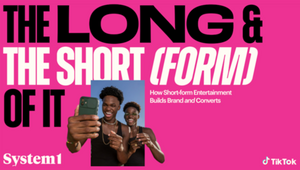
Advertising: Where Is the Love?

Love stories are some of the oldest stories there are. Go back to the roots of every cultural tradition in the world and you’ll find tales of love, lust and desire. And in an era where creatives and marketers consider themselves great storytellers, love should very much be in the advertising air.
Except it isn’t. Last month at System1 we revealed the 100 most emotionally effective video ads of 2019 - 50 each from the US and the UK. This is the work which resonated most with viewers - the ads which created the highest levels of positive emotion when we tested them.
How many of the 100 do you think were love stories? One.
One solitary ad - a US spot, 'Forever Young', by Jeep - took a couple’s relationship as its focus, using SFX to jump back and forth between times and show how their happiness endured. The ad got 5-Stars (our highest score) but it’s the sole example of a romantic story in an entire year’s worth of top-scoring ads.
This isn’t a case of adland sensibilities versus the public, either. The rest of the FeelMore50 list is a hall of fame of proudly populist advertising - frolicking dogs, sassy kids, broad humour, stories of courage and empowerment. There are plenty of relationships too - friends, like the one between girl and dragon in last year’s John Lewis Christmas ad; neighbours, like the kids and the old man in Cadbury’s 'Fence'; parents and children, like the dad and daughter in Argos’ festive 'Book Of Dreams'; and many others. There’s plenty of love to go around, in fact - just not romantic love.
It’s not like marketers have always stayed away from the topic. The famous '80s series of ads for Nescafe Gold Blend spun a will-they-won’t-they romance out over a dozen commercials which did wonders for the brand’s fame. '80s and '90s ads for Wrigley’s showed couples meeting over sticks of gum. Even this decade there have been KFC’s 'Love Is Forever' (tracking another couple through the ages) and Match.com’s train station guitar Romeo.
So why is such a primal story idea so neglected by current advertisers? There are several possible factors. There’s caution over regulation - in several categories, you’re not allowed to associate your product with sexual attractiveness, which nips a lot of love stories in the bud. Ads which poke fun at aspects of a relationship can risk breaching new guidelines on gender stereotyping. In a world that’s far more aware of different sexual and gender identities, there’s a question of whose love stories brands want to be telling. And with the TV watching population skewing older, perhaps it’s not surprising there’s more emphasis on parenting than passion.
But all these factors also feel a little like excuses. Most of the classic ad love stories of the past wouldn’t have fallen foul of regulators. Brands like Renault have put same-sex love at the centre of ads. And as that Jeep ad shows, you can tell stories about older people in love as effectively as you can any other age.
Some of it may be down to fashion. But some of it is likely to be a matter of style. In my book Lemon, I demonstrate the decline of elements in advertising which caught the attention of people’s right-brains. The right-brain, as opposed to the left-brain, pays attention to depth, and relationships between things and people. (The left uses more focused attention, flattening and abstracting the world).
One of the core right-brain elements in advertising is between-ness - communication between living characters, whether via dialogue or non-verbal, implicit communication. Between-ness is at the heart of many of the top-scoring ads on System1’s list, and obviously it powers almost every love story too.
The left-brained style of advertising, though, has been on the rise in recent years, and is stony ground for romance. It strips out context, preferring flat, abstract locations, using people as props for brands rather than as characters with agency, and often employing rapid-fire cuts and scene changes which make storytelling and between-ness harder.
One of the most famous 'romantic' ads of the 2010s is a great example of left- and right-brained features clashing in ads. Clothing brand Wren’s 'First Kiss' video - staging kisses between strangers - went viral in 2014. The topic guarantees lots of between-ness - there’s plenty of awkward dialogue and non-verbal communication as the kissers meet. But the execution is strongly left-brained - the action takes place in a grey void, the set-up is deliberately non-naturalistic and context-free, and the video chops rapidly between couples, avoiding a single story. When we tested it, 'First Kiss' scored a meagre 2-Stars, smothering its positive feeling with its alienating style.
Romantic ads can still do well with audiences - there’s plenty of room for fun as well as poignancy in the rituals and pitfalls of modern dating. But it’s likely to happen as part of a wider revival of more humanist right-brained advertising with broad appeal.
Orlando Wood is chief innovation officer at System1












